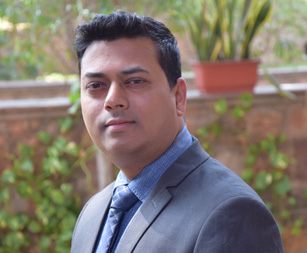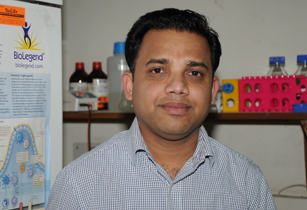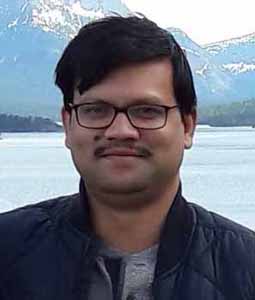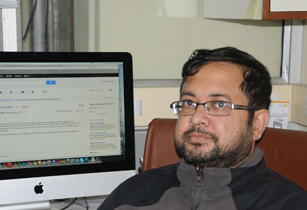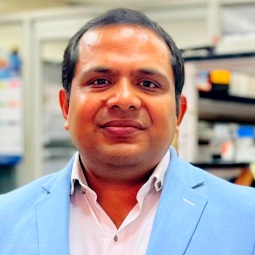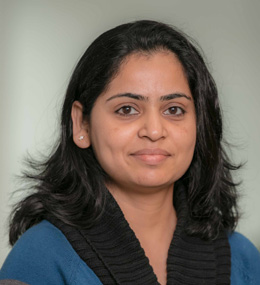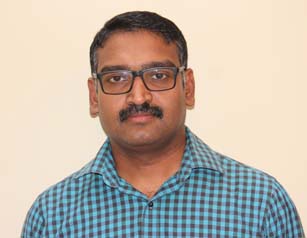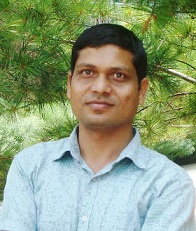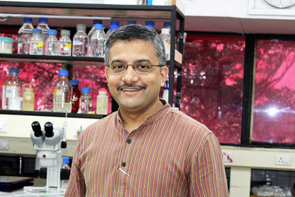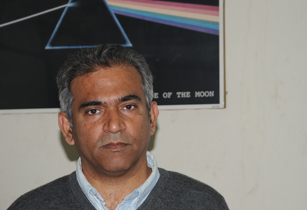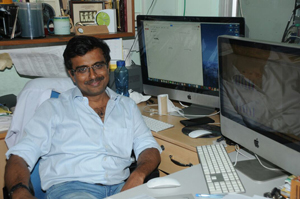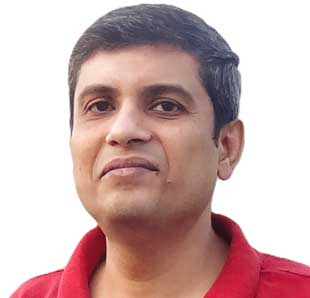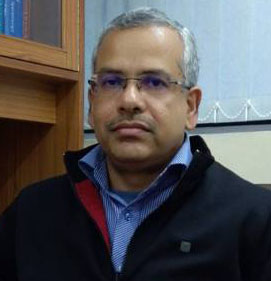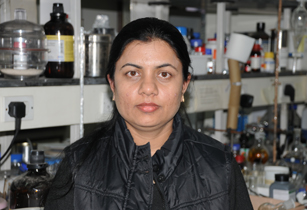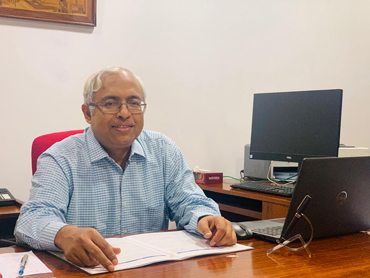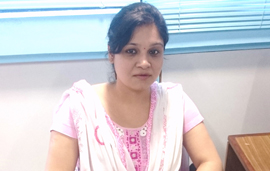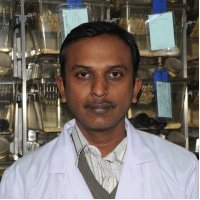Dr. S. Gopalan Sampathkumar
We strive to exploit the power of synthetic small molecules for development of tools for ‘glycomics/glycoproteomics’, carbohydrate-based inhibitors, and synthetic oligosaccharide-based conjugate vaccines. Using ‘chemical biology’ approaches we are investigating structure-function relationships of glycoforms of leukocyte antigens, engineering of glycans in central nervous system (CNS), and glycopeptidomimetics based anti-metastatic agents.
We are interested in the investigation of the significance, structure, and functional roles of glycoconjugates – which include glycoproteins (GP), glycolipids (GL), glycosaminoglycans (GAG), and glycosylphosphatidyl inositol (GPI) anchors, and bacterial-derived capsular polysaccharides (CPS), lipopolysaccharides (LPS), peptidoglycans (PG) – in fundamental biological and immunological processes using the tools of chemical biology, in an interdisciplinary manner.
Among more than 30 post-translational modifications (PTM) that are known to date – http://selene.princeton.edu/PTMCuration/, glycosylation is the most complex. Unlike template-driven biosynthesis of DNA, RNA, and proteins, glycans are bio-synthesized through non-template driven metabolic pathways. Glycans are linear or branched oligosaccharide or polysaccharide chains wherein monosaccharides are connected through a ‘glycosidic bond’. Like nucleotides for genes and amino acid building blocks for proteins, mammalian systems employ a limited number of monosaccharide building blocks for glycan biosynthesis (Ref: for beginners and advanced level – Essential of Glycobiology, 2nd ed., Varki, A., et al (2009); available at http://www.ncbi.nlm.nih.gov/books/NBK1908/.
Research in glycobiology and carbohydrate chemistry for more than a century has established that carbohydrates constituting the ‘glycocalyx’ on mammalian cell surface govern cell-cell, cell-matrix, and cell-pathogen interactions. Glycans regulate biological processes such as fertilization, differentiation, migration, immune response, and homeostasis. Importance of carbohydrates in day-to-day life are established in the context of blood group antigens, tissue transplantation, vaccines against infectious bacteria, drugs for treatment of influenza, and biopharmaceuticals.
Structure-function correlation studies of glycans have been hampered not only because of inherent complexity, but also by lack of tools to address challenges. While synthesis of nucleotides and peptides could be achieved routinely with automation no such technologies exist for oligosaccharides. Proteins and nucleotides could be visualised using fluorescence techniques but not glycans. However, post-genomic era has seen rapid growth in realization of importance of glycoforms in biomedicine and development of tools to address challenges unique to study of glycans. These include LC-MS based methodologies, development of metabolic glycans engineering (MGE) in living animals, selective inhibitors of glycan biosynthesis, and array technologies (glycan and lectin arrays).
Key Questions:
- How do cell surface glycans, either dependent or independent of the protein carrier, regulate biological/immunological processes?
- How to develop small molecules that could intercept or alter biosynthesis of glycans thus enabling carbohydrate-based drug development?
- How to deliver carbohydrate based small molecules across blood brain barrier (BBB) to central nervous system (CNS) for study of role of glycosylation in neurological development and diseases?
- How to design carbohydrate-based drugs for development of anti-metastatic and anti-cancer agents?
Techniques employed in our CGB laboratory:
Synthetic organic and carbohydrate chemistry: Our studies involve multi-step multi-gram scale synthesis of monosaccharide analogs, glycopeptides, and oligosaccharides. We apply protecting / de-protecting methodologies, glycosidation reactions, and armed-disarmed strategies for stereochemical control. We employ TLC, flash column chromatography, and HPLC for purifications and NMR (1H and 13C) and mass spectrometry for characterization of small molecules.
Enzymatic studies: We develop and conduct biochemical inhibition assays – based on absorbance / fluorescence spectrometers – using enzymes in vitro for evaluation of catalysis and inhibition by small molecules.
In vitro biochemistry: We evaluate effect of small molecules on cellular physiology, including glycosylation pathways, using mammalian cell lines followed by western blotting, immunoprecipitation, RT-PCR, real-time PCR, ELISA, and enzymatic assays.
In vitro cell biology: We evaluate small molecules for effects using techniques such as flow cytometry and microscopy. We establish cell lines that stably express tagged (e.g. FLAG) cell surface glycoproteins to facilitate their isolation, purification, and characterization.
Glycomics and glycoproteomics: For characterization of glycans from glycoproteins, cells, or tissues we employ enzymatic deglycosylation and reductive elimination. Glycans are permethylated and characterized by MALDI-TOF MS. Alternatively, released glycans are derivatized with fluorophores for analysis by UPLC. We develop novel tools and methodologies to facilitate identification and characterization of mammalian glycoproteome using nano-LC-ESI-MS/MS based approaches.
Animal studies: Based on outcome of in vitro cellular and biochemical studies, we evaluate our small molecules in multiple strains of mice in vivo for delivery to CNS and modulation of glycoforms of cell surface antigens and its consequences.
Ms. Surbhi Goswami, Ms. Vandita Dwivedi, Ms. Pratima Saini, Ms. Ahana Addhya, Ms. Anam Tasneem, Mr. Shubham Parashar, and Ms. Charu Chauhan
Technical Support - Ms. Archana Ranjan, Mr. Mohd. Aslam, Mr. P. Rajkumar
Past Members - Dr. Kavita Agarwal, Dr. Asif Shajahan, Dr. Syed Meheboob Ahmed, Dr. Rachna Kaul, Ms. Monika Garg, Ms. Deepshikha Singh, Ms. Priti Singh, Ms. Hemaswasthi, Mr. Saroj Kumar Jha, Mr. Sebanta (Sanjay) Pokhrel, Mr. Arnob Nandi.
Awards:
• Ramalingaswami Fellowship, Department of Biotechnology (DBT), Government of India.
- Shajahan, A., Parashar, S., Goswami, S., Ahmed, S. M., Nagarajan, P., Sampathkumar, S.-G. (2017) Carbohydrate-Neuroactive Hybrid Strategy for Metabolic Glycan Enginereing of the Central Nervous System in Vivo. J. Am. Chem. Soc. 139: 693-700.
- Agarwal, K., Kaul, R., Garg, M., Shajahan, A., Jha, S. K., Sampathkumar, S.-G. (2013) Inhibition of mucin-type O-glycosylation through metabolic processing and incorporation of N-thioglycolyl-D-galactosamine peracetate (Ac5GalNTGc). J. Am. Chem. Soc. 135: 14189-97.
- Du, J., Che, P. L., Aich, U., Tan, E., Kim, H. J., Sampathkumar, S. -G., Yarema, K. J. (2011) Deciphering glycan linkages involved in Jurkat cell interactions with gold-coated nanofibers via sugar-displayed thiols. Bioorg Med Chem Lett 21: 4980-4984.
- Gupta, G., Surolia, A., Sampathkumar, S. -G. (2010) Lectin microarrays for glycomic analysis. OMICS 14: 419-436.
- Aich, U., Meledeo, M. A., Sampathkumar, S. -G., Fu, J., Jones, M. B., Weier, C. A., Chung, S. Y., Tang, B. C., Yang, M., Hanes, J., Yarema, K. J. (2010) Development of delivery methods for carbohydrate-based drugs: controlled release of biologically-active short chain fatty acid-hexosamine analogs. Glycoconj J. 27: 445-459.
- Campbell, C. T., Sampathkumar, S. -G., Yarema, K. J. (2007) Metabolic oligosaccharide engineering: perspectives, applications, and future directions. Mol. Biosyst. 3: 187-194 (2007) (Review article).
- Sampathkumar, S. -G., Jones, M. B., Meledeo, M. A., Campbell, C. T., Choi, S. S., Hida, K., Gomutputra, P., Sheh, A., Gilmartin, T., Head, S. R., Yarema, K. J. (2006) Targeting glycosylation pathways and the cell cycle: sugar-dependent activity of butyrate-carbohydrate cancer prodrugs. Chem Biol. 13, 1265-1275.
- Sampathkumar, S. -G., Li, A., Yarema, K. J. (2006) Sialic acid and the central nervous system: perspectives on biological functions, detection, imaging methods and manipulation. CNS Neurol Disord. Drug Targets. 5: 425-440.
- Pozsgay, V., Ekborg, G., Sampathkumar, S. -G. (2006) Synthesis of hexa- to tridecasaccharides related to Shigella dysenteriae type 1 for incorporation in experimental vaccines. Carbohydr. Res. 341: 408-1427.
- Sampathkumar, S. -G., Li, A. V., Yarema, K. J. (2006) Synthesis of non-natural ManNAc analogs for the expression of thiols on cell-surface sialic acids. Nat. Protoc. 1: 2377-2385.
- Sampathkumar, S. G., Li, A. V., Jones, M. B., Sun, Z., Yarema, K. J. (2006) Metabolic installation of thiols into sialic acid modulates adhesion and stem cell biology. Nat. Chem Biol 2: 149-152.
- Kim, E. J., Sampathkumar, S. -G., Jones, M. B., Rhee, J. K., Baskaran, G., Goon, S., Yarema, K. J. (2004) Characterization of the metabolic flux and apoptotic effects of O-hydroxyl- and N-acyl-modified N-acetylmannosamine analogs in Jurkat cells. J Biol Chem 279, 18342-18352.



